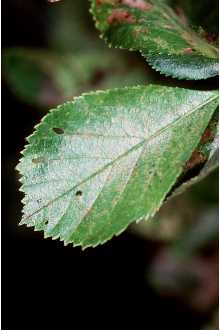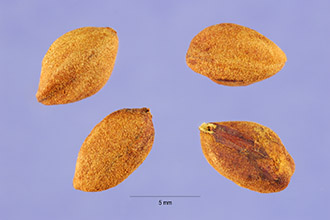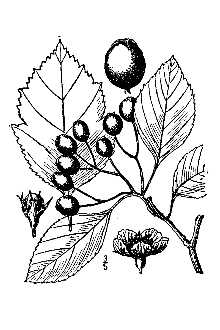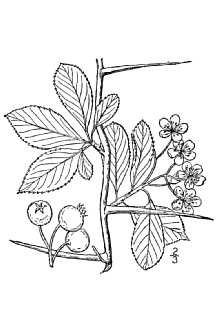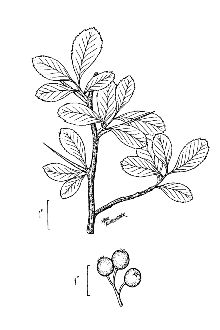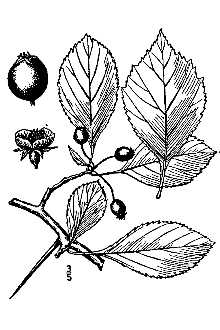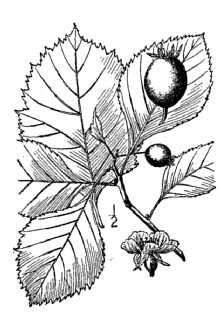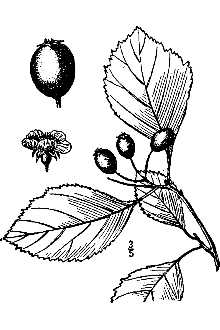Cockspur Hawthorn
Scientific Name: Crataegus crus-galli L.
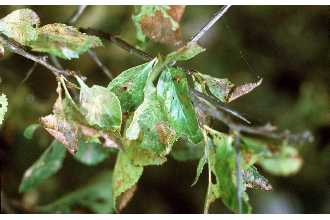
| General Information | |
|---|---|
| Usda Symbol | CRCR2 |
| Group | Dicot |
| Life Cycle | Perennial |
| Growth Habits | ShrubTree, |
| Native Locations | CRCR2 |
Plant Guide
Uses
Erosion Control: Because it tolerates a wide variety of sites, it can be planted to stabilize banks, for shelterbelts, and for erosion control. Wildlife: It provides excellent cover and nesting sites for many smaller birds. The small fruits are eaten by many birds especially cedar waxwings, fox sparrows, and ruffed grouse; rodents and other smaller birds. White tailed deer and mule deer browse the young twigs and leaves. Beautification: Excellent in group plantings, deciduous screens, groupings, tall barrier hedge, and seasonal accent tree.
Status
Please consult the PLANTS Web site and your State Department of Natural Resources for this plant’s current status, such as, state noxious status, and wetland indicator values, , Use soil moisture sensors to measure the soil moisture of Cockspur Hawthorn.
Description
General: It is a small tree that grows twenty to thirty feet high, twenty to thirty-five feet wide; with wide-spreading, horizontal, thorny branches. Leaves are broadest above or near the middle, thick, leathery, shiny dark green above, usually not lobed, and smooth. Flowers ranging from white to red are produced in clusters. Fruits are broadest above the middle or rounded, dull red or green.
Native Trees of Texas
Department of Horticulture Texas A&M University Distribution: Cockspur hawthorn grows from southern Quebec, and Ontario to northern Louisiana, Alabama and northwestern Georgia, and west to Kansas.
Adaptation
Although Cockspur hawthorn generally requires no special soil requirements, it prefers a moist, well-drained, slightly acid soils, and full sunlight. It is adaptable to poor soils; various soil pHs, compacted soils, drought, heat and winter salt spray. Adapted to USDA Hardiness Zone 4.
Establishment
Propagation from Seed or Grafting: Cockspur hawthorn can be propagated by seeds or by stem cuttings grafted onto seedling rootstock.
Propagation
using seeds requires acid scarification for two to three hours followed by three months warm stratification and another three months prechilling. Seeds are planted in drill rows eight to twelve inches apart and covered with 1/4 inch of soil. Containerized trees should be planted when they are no more than eight feet tall, in the fall or spring. Grafts are budded on seedling understock in August and September.
Management
Seedlings develop taproot, thus should not be kept in seedbeds longer than one year. Balled and burlapped trees should be planted in early spring. If transplanted in autumn, amend soil, fertilize, water thoroughly, mulch adequately and avoid winter salt spray. Pruning should be done in the winter or early spring in order to maintain a clear shoot leader on young trees and/or remove the weakest branches to allow more light to pass through. Suckers or stems arising from the roots should be removed when they become noticeable.
Pest and Potential Problems
Cedar hawthorn rust affects the fruit, foliage and stems. Potential pests include leaf blotch minor. Cultivars, Improved and Selected Materials (and area of origin) Consult you local nurseries to choose the right cultivar for your specific landscape. Contact your local Natural Resources Conservation Service (formerly Soil Conservation Service) office for more information. Look in the phone book under ”United States Government.” The Natural Resources Conservation Service will be listed under the subheading “Department of Agriculture.”
References
Dirr, M.A. 1990. Manual of woody landscape plants: their identification, ornamental characteristics, culture, propagation and uses. 3rd ed. Stipes, Champaign, Illinois. Duncan, W.H. & M.B. Duncan 1988. Trees of the Southeastern United States. University of Georgia Press, Athens, Georgia. Elias, T.S. 1989. Field guide to North American trees. Revised ed. Grolier Book Clubs Inc., Danbury, Connecticut. Flint, H.L. 1983. Landscape plants for eastern North America. John Wiley and Sons, Inc, New York, New York. Harrar, E.S. & J.G. Harrar. 1962. Guide to southern trees. 2nd ed. Dover Publications, Inc., New York, New York. Little, E.E. 1996. National Audubon Society field guide to North American trees: Eastern region. Alfred A. Knopf, New York, New York. Texas A&M University 2002. Native trees of Texas. Department of Horticulture, College Station, Texas. Accessed: 11jan02. <http://aggie-horticulture.tamu.edu/ornamentals/natives/indexscientific.htm> USDA Forest Service 1974. Seeds of woody plants in the United States. Agricultural Handbook 450. USDA, Washington, DC. USDA Forest Service 1990. Silvics of North America. Agricultural Handbook 654. Forest Service, USDA, Washington, DC. Young, J. A. & C.G. Young. 1992. Seeds of woody plants in North America. Revised and enlarged ed. Dioscorides Press, Portland, Oregon
Plant Traits
Growth Requirements
| Temperature, Minimum (°F) | -33 |
|---|---|
| Adapted to Coarse Textured Soils | Yes |
| Adapted to Fine Textured Soils | Yes |
| Adapted to Medium Textured Soils | Yes |
| Anaerobic Tolerance | None |
| CaCO3 Tolerance | High |
| Cold Stratification Required | Yes |
| Drought Tolerance | High |
| Fertility Requirement | Low |
| Fire Tolerance | Medium |
| Frost Free Days, Minimum | 90 |
| Hedge Tolerance | Medium |
| Moisture Use | Low |
| pH, Maximum | 7.2 |
| pH, Minimum | 4.5 |
| Planting Density per Acre, Maxim | 1200 |
| Planting Density per Acre, Minim | 300 |
| Precipitation, Maximum | 60 |
| Precipitation, Minimum | 24 |
| Root Depth, Minimum (inches) | 24 |
| Salinity Tolerance | Medium |
| Shade Tolerance | Intolerant |
Morphology/Physiology
| Bloat | None |
|---|---|
| Toxicity | None |
| Resprout Ability | Yes |
| Shape and Orientation | Erect |
| Active Growth Period | Spring and Summer |
| C:N Ratio | High |
| Coppice Potential | No |
| Fall Conspicuous | Yes |
| Fire Resistant | No |
| Flower Color | White |
| Flower Conspicuous | Yes |
| Foliage Color | Green |
| Foliage Porosity Summer | Dense |
| Foliage Porosity Winter | Moderate |
| Foliage Texture | Medium |
| Fruit/Seed Conspicuous | Yes |
| Nitrogen Fixation | None |
| Low Growing Grass | No |
| Lifespan | Long |
| Leaf Retention | No |
| Known Allelopath | No |
| Height, Mature (feet) | 30.0 |
| Height at 20 Years, Maximum (fee | 30 |
| Growth Rate | Moderate |
| Growth Form | Single Stem |
| Fruit/Seed Color | Red |
Reproduction
| Vegetative Spread Rate | None |
|---|---|
| Small Grain | No |
| Seedling Vigor | Medium |
| Seed Spread Rate | Moderate |
| Seed per Pound | 5000 |
| Fruit/Seed Persistence | Yes |
| Propagated by Tubers | No |
| Propagated by Sprigs | No |
| Propagated by Sod | No |
| Propagated by Seed | Yes |
| Propagated by Corm | No |
| Propagated by Cuttings | No |
| Bloom Period | Late Spring |
| Commercial Availability | Routinely Available |
| Fruit/Seed Abundance | High |
| Fruit/Seed Period Begin | Summer |
| Fruit/Seed Period End | Fall |
| Propagated by Bare Root | Yes |
| Propagated by Bulb | No |
| Propagated by Container | Yes |
Suitability/Use
| Veneer Product | No |
|---|---|
| Pulpwood Product | No |
| Protein Potential | Low |
| Post Product | No |
| Palatable Human | No |
| Palatable Graze Animal | Low |
| Palatable Browse Animal | Medium |
| Nursery Stock Product | Yes |
| Naval Store Product | No |
| Lumber Product | No |
| Fuelwood Product | Medium |
| Fodder Product | No |
| Christmas Tree Product | No |
| Berry/Nut/Seed Product | No |

